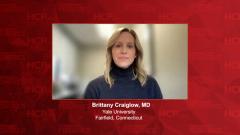
Role of Multidisciplinary Management for Pediatric AD
Expert dermatologists discuss the role of a multidisciplinary care team in treating pediatric AD and the modes of communication between specialists and pediatricians.
Episodes in this series

Brittany Craiglow, MD: There are a lot more tools in our toolbox now. Part of this is us educating the pediatricians, saying, hey, we have more things now. Yes, we do topical corticosteroids, but we have these other options. We have dupilumab now for kids who are severe or moderate to severe. There is this mentality sometimes that the kid’s going to grow out of it. And, sometimes, maybe the referral doesn’t happen. I think, wow, how did it take you so long to get here? And I’ve heard from kids that they said he’d grow out of it. Maybe he will, but in the meantime, he’s suffering. Treating it is important. Especially with what we know about the atopic march. It’s important to get the skin clear as early as we can. I don’t know if, where you are, you’re doing any e-consults or reviewing images, but at Yale now, we do have a pediatric dermatology e-consult program where pediatric providers can take photos, they get uploaded to the chart, they send their questions, and then we review them. Oftentimes it’s something that we can give recommendations for, which the pediatrician can carry out. Then if that doesn’t work, we have a contingency plan that they can come to our clinic, or for somebody who is more severe, we can fast-track them in to get to see a dermatologist.These things are starting to pop up. Do you have anything like that?
Angela J. Lamb, MD: Yes. We do have a robust e-consult program, not specifically for pediatrics, but pediatricians are involved and can be included in that. We also are looking at an e-visit type of format. For patients, I may have seen some patients for something else—molluscum, what have you—but now they have atopic dermatitis, they might send me a question, and then we have to figure out how to code and bill for that to create that access. You’re right, e-consults have been a great model; a lot of white papers have been written about that to improve access and get people care much faster. And then sometimes, because it decamps, it allows us to say, hey, this person doesn’t need to be seen tomorrow, they can try this and then be seen in a month or so. We have a visit for them. All of those things create access and, I believe, provide much better patient care.
Brittany Craiglow, MD: For the referring pediatricians, it’s great too because you learn, and then the next time they see a patient with something similar, they can remember or even look back at what the plan was and try that first. That may, like you said, distill out the kids who need to be seen. The wait times are not as long, etc. I have, in my community, pediatrician friends who have my number. There are papers written about pediatric dermatologists, how much time we spend on off-hours managing other patients. But it’s nice, too, if you have a dermatologist in your community who you have a relationship with and can have a little back-and-forth, or someone to help get a patient in and all that. I find it nice to connect, and it’s a way to get kids help when they might not have it.
Angela J. Lamb, MD: Yes. I know people complain there’s a lot of burnout with EMR [electronic medical record] iteration, but I think when used appropriately, it can be a powerful tool. What I try to help other physicians understand is as burdensome as they may feel that it is, imagine those patients would try to contact you some way. If it weren’t on your MyChart or something like that, they would be calling you. This allows you to manage and have some agency about when you do it or what have you; you imagine at the end of your day looking at 30 telephone messages that haven’t been responded to. It’s about a worldview…. So there are clear issues that we need to manage, but also we need to think about how we can provide better care and manage some of it in a way that’s tenable for us.
Transcript edited for clarity
Newsletter
Access practical, evidence-based guidance to support better care for our youngest patients. Join our email list for the latest clinical updates.








